[English] 日本語
 Yorodumi
Yorodumi- PDB-6u9w: Cryo electron microscopy structure of the ATP-gated rat P2X7 ion ... -
+ Open data
Open data
- Basic information
Basic information
| Entry | Database: PDB / ID: 6u9w | |||||||||
|---|---|---|---|---|---|---|---|---|---|---|
| Title | Cryo electron microscopy structure of the ATP-gated rat P2X7 ion channel in the ATP-bound, open state | |||||||||
 Components Components | P2X purinoceptor 7 | |||||||||
 Keywords Keywords | MEMBRANE PROTEIN / Ion Channel Apoptosis | |||||||||
| Function / homology |  Function and homology information Function and homology informationThe NLRP3 inflammasome / regulation of presynaptic dense core granule exocytosis / Platelet homeostasis / positive regulation of lymphocyte apoptotic process / positive regulation of bleb assembly / NAD transport / phagolysosome assembly / Elevation of cytosolic Ca2+ levels / phospholipid transfer to membrane / positive regulation of cytoskeleton organization ...The NLRP3 inflammasome / regulation of presynaptic dense core granule exocytosis / Platelet homeostasis / positive regulation of lymphocyte apoptotic process / positive regulation of bleb assembly / NAD transport / phagolysosome assembly / Elevation of cytosolic Ca2+ levels / phospholipid transfer to membrane / positive regulation of cytoskeleton organization / lymphocyte apoptotic process / positive regulation of monoatomic ion transmembrane transport / purinergic nucleotide receptor signaling pathway / gamma-aminobutyric acid secretion / pore complex assembly / extracellularly ATP-gated monoatomic cation channel activity / purinergic nucleotide receptor activity / positive regulation of interleukin-1 alpha production / plasma membrane organization / positive regulation of gamma-aminobutyric acid secretion / bleb / plasma membrane phospholipid scrambling / collagen metabolic process / negative regulation of cell volume / ATP export / T cell apoptotic process / positive regulation of prostaglandin secretion / bleb assembly / response to fluid shear stress / mitochondrial depolarization / vesicle budding from membrane / ceramide biosynthetic process / positive regulation of T cell apoptotic process / programmed cell death / prostaglandin secretion / positive regulation of ossification / cellular response to dsRNA / positive regulation of glutamate secretion / cell volume homeostasis / glutamate secretion / negative regulation of bone resorption / skeletal system morphogenesis / positive regulation of macrophage cytokine production / phospholipid translocation / response to zinc ion / response to ATP / positive regulation of calcium ion transport into cytosol / positive regulation of mitochondrial depolarization / positive regulation of NLRP3 inflammasome complex assembly / : / T cell homeostasis / synaptic vesicle exocytosis / membrane protein ectodomain proteolysis / protein secretion / monoatomic cation transport / membrane depolarization / negative regulation of MAPK cascade / positive regulation of bone mineralization / response to electrical stimulus / neuronal action potential / response to mechanical stimulus / T cell proliferation / regulation of sodium ion transport / extrinsic apoptotic signaling pathway / homeostasis of number of cells within a tissue / release of sequestered calcium ion into cytosol / sensory perception of pain / reactive oxygen species metabolic process / protein serine/threonine kinase activator activity / positive regulation of glycolytic process / positive regulation of interleukin-1 beta production / positive regulation of protein secretion / mitochondrion organization / establishment of localization in cell / response to bacterium / apoptotic signaling pathway / lipopolysaccharide binding / protein catabolic process / : / T cell mediated cytotoxicity / cell morphogenesis / terminal bouton / neuromuscular junction / calcium ion transmembrane transport / protein processing / positive regulation of T cell mediated cytotoxicity / positive regulation of interleukin-6 production / response to calcium ion / calcium ion transport / MAPK cascade / nuclear envelope / cell-cell junction / signaling receptor activity / channel activity / scaffold protein binding / gene expression / response to lipopolysaccharide / cell surface receptor signaling pathway / positive regulation of MAPK cascade / defense response to Gram-positive bacterium Similarity search - Function | |||||||||
| Biological species |  | |||||||||
| Method | ELECTRON MICROSCOPY / single particle reconstruction / cryo EM / Resolution: 3.3 Å | |||||||||
 Authors Authors | Mansoor, S.E. / McCarthy, A.E. | |||||||||
| Funding support |  United States, 1items United States, 1items
| |||||||||
 Citation Citation |  Journal: Cell / Year: 2019 Journal: Cell / Year: 2019Title: Full-Length P2X Structures Reveal How Palmitoylation Prevents Channel Desensitization. Authors: Alanna E McCarthy / Craig Yoshioka / Steven E Mansoor /  Abstract: P2X receptors are trimeric, non-selective cation channels activated by extracellular ATP. The P2X receptor subtype is a pharmacological target because of involvement in apoptotic, inflammatory, and ...P2X receptors are trimeric, non-selective cation channels activated by extracellular ATP. The P2X receptor subtype is a pharmacological target because of involvement in apoptotic, inflammatory, and tumor progression pathways. It is the most structurally and functionally distinct P2X subtype, containing a unique cytoplasmic domain critical for the receptor to initiate apoptosis and not undergo desensitization. However, lack of structural information about the cytoplasmic domain has hindered understanding of the molecular mechanisms underlying these processes. We report cryoelectron microscopy structures of full-length rat P2X receptor in apo and ATP-bound states. These structures reveal how one cytoplasmic element, the C-cys anchor, prevents desensitization by anchoring the pore-lining helix to the membrane with palmitoyl groups. They show a second cytoplasmic element with a unique fold, the cytoplasmic ballast, which unexpectedly contains a zinc ion complex and a guanosine nucleotide binding site. Our structures provide first insights into the architecture and function of a P2X receptor cytoplasmic domain. | |||||||||
| History |
|
- Structure visualization
Structure visualization
| Movie |
 Movie viewer Movie viewer |
|---|---|
| Structure viewer | Molecule:  Molmil Molmil Jmol/JSmol Jmol/JSmol |
- Downloads & links
Downloads & links
- Download
Download
| PDBx/mmCIF format |  6u9w.cif.gz 6u9w.cif.gz | 575.3 KB | Display |  PDBx/mmCIF format PDBx/mmCIF format |
|---|---|---|---|---|
| PDB format |  pdb6u9w.ent.gz pdb6u9w.ent.gz | 484.4 KB | Display |  PDB format PDB format |
| PDBx/mmJSON format |  6u9w.json.gz 6u9w.json.gz | Tree view |  PDBx/mmJSON format PDBx/mmJSON format | |
| Others |  Other downloads Other downloads |
-Validation report
| Summary document |  6u9w_validation.pdf.gz 6u9w_validation.pdf.gz | 1.9 MB | Display |  wwPDB validaton report wwPDB validaton report |
|---|---|---|---|---|
| Full document |  6u9w_full_validation.pdf.gz 6u9w_full_validation.pdf.gz | 2 MB | Display | |
| Data in XML |  6u9w_validation.xml.gz 6u9w_validation.xml.gz | 59.5 KB | Display | |
| Data in CIF |  6u9w_validation.cif.gz 6u9w_validation.cif.gz | 85.3 KB | Display | |
| Arichive directory |  https://data.pdbj.org/pub/pdb/validation_reports/u9/6u9w https://data.pdbj.org/pub/pdb/validation_reports/u9/6u9w ftp://data.pdbj.org/pub/pdb/validation_reports/u9/6u9w ftp://data.pdbj.org/pub/pdb/validation_reports/u9/6u9w | HTTPS FTP |
-Related structure data
| Related structure data |  20703MC  6u9vC M: map data used to model this data C: citing same article ( |
|---|---|
| Similar structure data |
- Links
Links
- Assembly
Assembly
| Deposited unit | 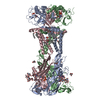
|
|---|---|
| 1 |
|
- Components
Components
-Protein , 1 types, 3 molecules ABC
| #1: Protein | Mass: 69904.016 Da / Num. of mol.: 3 Source method: isolated from a genetically manipulated source Source: (gene. exp.)   Homo sapiens (human) / References: UniProt: Q64663 Homo sapiens (human) / References: UniProt: Q64663 |
|---|
-Sugars , 2 types, 12 molecules 
| #2: Polysaccharide | 2-acetamido-2-deoxy-beta-D-glucopyranose-(1-4)-2-acetamido-2-deoxy-beta-D-glucopyranose #5: Sugar | ChemComp-NAG / |
|---|
-Non-polymers , 5 types, 27 molecules 
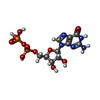
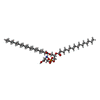
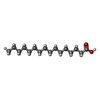





| #3: Chemical | ChemComp-ZN / #4: Chemical | #6: Chemical | #7: Chemical | ChemComp-PLM / #8: Chemical | |
|---|
-Details
| Has ligand of interest | Y |
|---|---|
| Has protein modification | Y |
-Experimental details
-Experiment
| Experiment | Method: ELECTRON MICROSCOPY |
|---|---|
| EM experiment | Aggregation state: PARTICLE / 3D reconstruction method: single particle reconstruction |
- Sample preparation
Sample preparation
| Component | Name: P2X7 receptor ion channel / Type: COMPLEX / Entity ID: #1 / Source: RECOMBINANT |
|---|---|
| Molecular weight | Experimental value: NO |
| Source (natural) | Organism:  |
| Source (recombinant) | Organism:  Homo sapiens (human) Homo sapiens (human) |
| Buffer solution | pH: 7 |
| Specimen | Embedding applied: NO / Shadowing applied: NO / Staining applied: NO / Vitrification applied: YES |
| Specimen support | Details: unspecified |
| Vitrification | Cryogen name: ETHANE |
- Electron microscopy imaging
Electron microscopy imaging
| Experimental equipment |  Model: Titan Krios / Image courtesy: FEI Company |
|---|---|
| Microscopy | Model: FEI TITAN KRIOS |
| Electron gun | Electron source:  FIELD EMISSION GUN / Accelerating voltage: 300 kV / Illumination mode: FLOOD BEAM FIELD EMISSION GUN / Accelerating voltage: 300 kV / Illumination mode: FLOOD BEAM |
| Electron lens | Mode: BRIGHT FIELD |
| Image recording | Electron dose: 44 e/Å2 / Film or detector model: GATAN K2 SUMMIT (4k x 4k) |
- Processing
Processing
| CTF correction | Type: PHASE FLIPPING ONLY |
|---|---|
| 3D reconstruction | Resolution: 3.3 Å / Resolution method: FSC 0.143 CUT-OFF / Num. of particles: 109570 / Symmetry type: POINT |
 Movie
Movie Controller
Controller




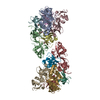

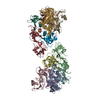
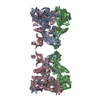
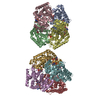
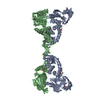
 PDBj
PDBj










